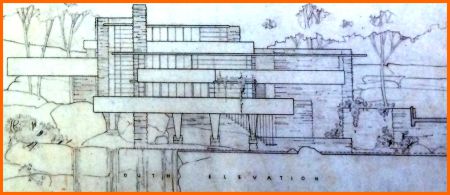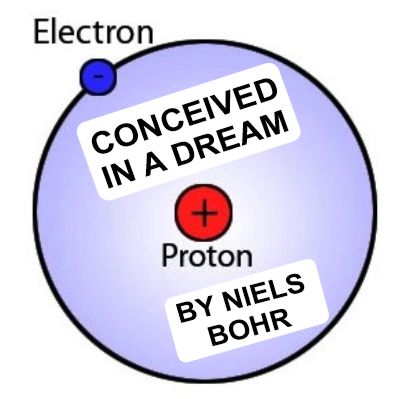In 1935, Edgar Kaufman Jr, commissioned Frank Lloyd Wright to design the house in Mill Run that became Fallingwater. The saga of the design of this masterpiece has become the stuff of legend. Here I postulate that dreaming was likely a factor – and that we can use the method of the master to nurture our own creativity:
After exploring every normal design strategy, pause for 4 to 5 weeks and allow yourself to dream. Then set up an artificial deadline by asking the client to stop by to see the design in, say, two days. Spend day one closeted in your office without interruptions. The adrenalin-induced urgency will remove your inhibitions and your subliminal subconscious will pour out onto the page.
The Amazing Saga of Fallingwater, PA

Arguably the most astonishing Frank Lloyd Wright story concerns the events that ensued when he learned that his client, Mr. Edgar Kaufman, was en route from Pittsburgh to check on his commission. The 67-year-old architect, regarded by many as an aging genius in the twilight of his career, had procrastinated for nine months since receiving a large cash deposit from his patron.
As the limo approached Taliesin, Lloyd Wright began a two-hour design marathon with assistants passing a continuous supply of sharpened pencils and hot coffee as he drew, erased, and redrew in a frenzy of inspired creativity.
At the end of this tumultuous brainstorm, he emerged with complete plans and elevations – final designs for the definitive masterpiece of American residential architecture – built into the fabric of the Pottsville sandstone and cantilevering over the ravine of Bear Run.
With a triumphant flourish of his pencil, Frank Lloyd Wright completed the Edgar Kaufman design and signed the drawings – Fallingwater.

For editorial completeness: there is a substantial controversy surrounding this narrative – some critics question the story but several eye-witnesses have corroborated its essential components.
The foundation for this miraculous performance relied on the combination of several advantages.
- First: Frank Lloyd Wright was very skilled and experienced, having designed hundreds of buildings over a career of more than forty years.
- Second: he had been cogitating and dreaming about this design challenge for at least nine months.
- Third: he had complete topographical maps and cross-sections of the site.
- Fourth: the deadline – the catalyst for the culmination of this process was the crisis of an enforced deadline that opened the floodgates of creativity in two hours of astonishing achievement.
As an Amazon Associate, I earn from Qualifying Purchases.
Here we concentrate on the specific 3-step strategy exemplified by the Fallingwater project.
Frank Lloyd Wright’s Method for Beating Designer’s Block
Step 1: Dream about the Project

When faced with an intractable design challenge, first, give it your best shot: consider the requirements of the client: identify the parameters of the problem: consult with colleagues, follow all the conventional strategies (explained in detail in this blog post), and then submit the design to the process of subliminal filtering. Ponder, contemplate, dream, and keep a notebook handy by your bedside for when you awake. (study the evidence for dream inventions by following this link).
Step 2: Set Yourself a Deadline

After an appropriate interlude (typically at least 5 weeks) challenge yourself by setting an artificial deadline. Call the client on Wednesday afternoon and state “I am putting the final touches to your design – could you stop by and take a look on – say Friday?” Read about the psychological importance of deadlines here.
Step 3: Isolate Yourself & Create!

Spend Thursday closeted in your office, with strong coffee. Isolate yourself entirely from phone calls, fellow workers, and other distractions. The impetus of the adrenaline generated by the fear of missing the deadline, combined with the accumulated subconscious wisdom, will often release your inhibitions and allow a flow of creativity – a neural download to take place.
Frank Lloyd Wright is not alive to confirm that this is the method that produced the miracle of Fallingwater, but the evidence is extremely suggestive and mirrors other famous examples of inspirations triggered by dreams:-
The scientist Friedrich August Kekulé spoke at an 1890 celebration of his discovery of the chemical structure of the benzene molecule 25 years previously and revealed that he had discovered the ring shape after having a reverie, or daydream, of a snake swallowing its own tail. He said that the vision had come to him after many years of studying the nature of carbon-carbon bonds.
Evidence for the Power of Dreams
Dreams have been credited with numerous important discoveries and creative breakthroughs. See this excellent summary on Wikipedia.
Dreams may be especially effective for coming up with creative solutions because they are believed to be generated in the hippocampus rather than in the pre-frontal cortex (PFC) of the brain. The PFC censors wild ideas and promotes sensible behavior. Since dreams are likely to be uncensored, ideas thus tend to be unconventional, counter-intuitive, or wacky.

Also, dreams are especially vivid in their visual-spatial imagery rather than in verbal or numerical information so the best dream breakthroughs most often involve images. Consider these spectacular examples:
.
The sewing machine
An account of how Elias Howe came up with the idea for placing the eye of the needle at the point to produce a sewing machine is recorded in a family history of his mother’s family:
“….. he dreamed he was building a sewing machine for a savage king in a strange country. Just as in his actual working experience, he was perplexed about the needle’s eye. He thought the king gave him twenty-four hours in which to complete the machine and make it sew. If not finished in that time death was to be the punishment. Howe worked and worked, and puzzled, and finally gave it up. Then he thought he was taken out to be executed. He noticed that the warriors carried spears that were pierced near the head. Instantly came the solution of the difficulty, and while the inventor was begging for time, he awoke. It was 4 o’clock in the morning. He jumped out of bed, ran to his workshop, and by 9, a needle with an eye at the point had been crudely modeled. After that it was easy. That is the true story of an important incident in the invention of the sewing machine.”
Terminator
Director James Cameron said the title character in The Terminator was inspired by a dream he had under the influence of a soaring fever. It was a vivid dream where a gleaming figure of doom emerged from fire; a metallic, skeletal monster with a rictus smile and burning red eyes, dragging itself across the floor with kitchen knives. He states: “I was sick and dead broke in Rome, Italy, with a fever of 102, doing the final cut of Piranha II. That’s when I thought of Terminator. I guess it was a fever dream.”
Double-helix structure of DNA
Nobel laureate James Watson tells the interesting story of how he and his research partner, Francis Crick, discovered the structure of DNA. James Watson, the co-discoverer, reported stumbling upon the double helix image for the DNA chain through his dream of a spiral staircase.
The molecular structure of benzene

August Kekulé von Stradonitz was a German chemist working without success on the chemical structure of benzene.
One afternoon while sleeping Kekulé was startled by the image of a snake biting its own tail in a dream. The hidden analogy enabled him to work out the equation of the benzene molecule. He proposed the structure of benzene is a ring rather than a long string.
Yesterday
Paul McCartney claimed to have dreamed the melody to his song Yesterday. After he woke up, he thought it was just a vague memory of some song he heard when he was younger. He asked friends, fellow musicians, and musical experts if they recognized the tune but none had. It turned out that he had composed a totally new song all by himself – he recorded it and it became the most often covered pop song in the world.
Niels Bohr’s structure of the atom

Niels Bohr won the Nobel Prize for Physics in 1922 for his discovery of the structure of the atom. He recalled that the concept of electrons revolving around the nucleus, like the solar system, came to him in a dream. Upon testing his “dream” hypothesis, he discovered that the atomic structure did indeed share some of the characteristics of a heliocentric system.
Mendeleev’s periodic table
Dmitri Mendeleev, who created the periodic table foundational to our understanding of chemistry, claimed to have envisioned the complete arrangement of the elements in a dream. While struggling to correctly orient the elements he recalls seeing a table where all elements fell into place as required. Awakening, he immediately wrote them down on a piece of paper, and only in one place did a correction later prove to be necessary.
Frankenstein
Mary Shelley’s Frankenstein was inspired by a dream:
“I saw the pale student of unhallowed arts kneeling beside the thing he had put together. I saw the hideous phantasm of a man stretched out, and then, on the working of some powerful engine, show signs of life, and stir with an uneasy, half-vital motion. Frightful must it be; for supremely frightful would be the effect of any human endeavor to mock the stupendous Creator of the world”.
J.K. Rowling’s Dementors
In an interview with the BBC, J.K. Rowling described the inspiration for the Dementors – the scary, ghostly guards of Azkaban in the Harry Potter novels.
“.. when I was a child … I had a dream … that I was hiding from a creature that looked like a dementor: the empty black cloak and the withered hand. It sort of drifted toward me. It didn’t seem to have feet. I was terrified.”
How to Maximise your Chances of Dreaming Productively
Place an image of the problem you are facing on your nightstand and concentrate on it before going to sleep. Repeat the question you would like to answer several times to yourself before going to sleep.
When you wake up do not immediately jump out of bed. Lie quietly to recollect your dream and immediately write down what you remember.
The Value of Deadlines
Remember, although deadlines can be painful they are an effective tool for overcoming procrastination and getting things done. Without a deadline, projects can lose focus and drag on and on.
The most important effects of deadlines in the context of this post are:-
Releasing Inhibitions
The knowledge that the job just has to be finished can instill a “just do it” fatalistic attitude by removing inhibitions associated with the fear of failure.
Accepting Imperfection
An enormous impediment to the completion of projects is the search for perfection. Many people desire absolute perfection in their craft, art, or career. Deadlines can help to drive through the roadblock of perfection.
Boosting Adrenalin
Steve Jobs was notorious for setting ruthless deadlines to motivate (some would say coerce or threaten) his employees. In these cases, the fear of missing a deadline will likely induce a rush of adrenalin that can be beneficial in the correct quantities (but can be career-ending if taken to excess).
Optimizing Workflow
Well-motivated people harness their creativity to re-engineer their workflows and resources to finish the job faster and exceed expectations. The search for efficiency in the meeting of deadlines fosters the sensible design of working methods.
A Gift for the Frank Lloyd Wright Enthusiast
FLW Philosophy Pen Set
I receive this very thoughtful gift from the membership of OPBA – in appreciation of my service as President and for my efforts in guiding the group during the difficult ordeal of the COVID year of 2020.
Highly recommended gift for the Frank Lloyd Wright fanatic.
Deadlines at Artistry in Glass
Many of our products and services are time-sensitive and Artistry in Glass has developed strategies to deal with deadlines. Most notable is our etching and engraving service, where awards almost always have a strict presentation date. Our regular customers can depend on us for next-day service if necessary. Study this web post for advice on how to design a crystal award.
Restoration Work Done to a Deadline
We cannot guarantee to meet every deadline with complicated repairs – but we will do our best. Check this impressive list of our restoration skills:
Artistry in Glass was your source for antique repair in Tucson
Check out this amazing selection of informative articles:-
- Where can I get antiques repaired?
- Are broken antiques worth fixing?
- How to fix a broken picture frame
- How to repair a broken china plate
- How to repair a broken china teapot
- How to fix a broken marble slab
- How to repair a broken china coffee mug
- How to repair a 2000-year-old sculpture
- All about repairing stained-glass lampshades
- How to care for your stained glass skylight
- How to repair Dalle de Verre
- Is stained glass worth repairing?
- To repair or toss out?
- Tucson crystal & china repair a division of Artistry in Glass
- What to do with broken antiques
- Is lead crystal dangerous?
- Repairing an antique Mexican statue
- Repairing religious statues
- The history of Swarovski crystal figurines
- How to find the value of a Swarovski Crystal figurine
- Have Swarovski crystal figurines lost value since 2009?
- How to collect Swarovski annual ornaments
- How to display Swarovski crystal figurines
- How to authenticate a Swarovski crystal figurine
- How to display Swarovski annual ornaments
- How to clean Swarovski crystal figurines
- How to repair a Swarovski crystal mouse
- How to repair a Swarovski annual ornament
- How to repair a Swarovski crystal train set
- Fixing broken wine glass stems
- How to clean cloudy glasses
- Why do wine glasses have stems?
- Swarovski Crystal Figurines
- How to repair a chip in a wine glass
- How to fix a scratched glass tabletop
- How to replace a broken patio tabletop
Unique Mirror Resources from Artistry in Glass
Mirror Design & layout
- How are mirrors made?
- What is a beveled mirror?
- What is a two-way mirror?
- Best mirrors for bedrooms
- How to size and position your wall mirror
- How to order custom etched mirrors
- Best places to hang dining room mirrors
- How much do wall mirrors cost?
- Shop the MIRROR Family Package
Mirror Installation & Removal
- How to hang a wall mirror
- How to frame a builder’s grade bathroom mirror
- How to hang a frameless mirror with glue
- Best clips for hanging mirrors
- How to attach a mirror to a closet door
- How to remove a mirror glued to the wall

